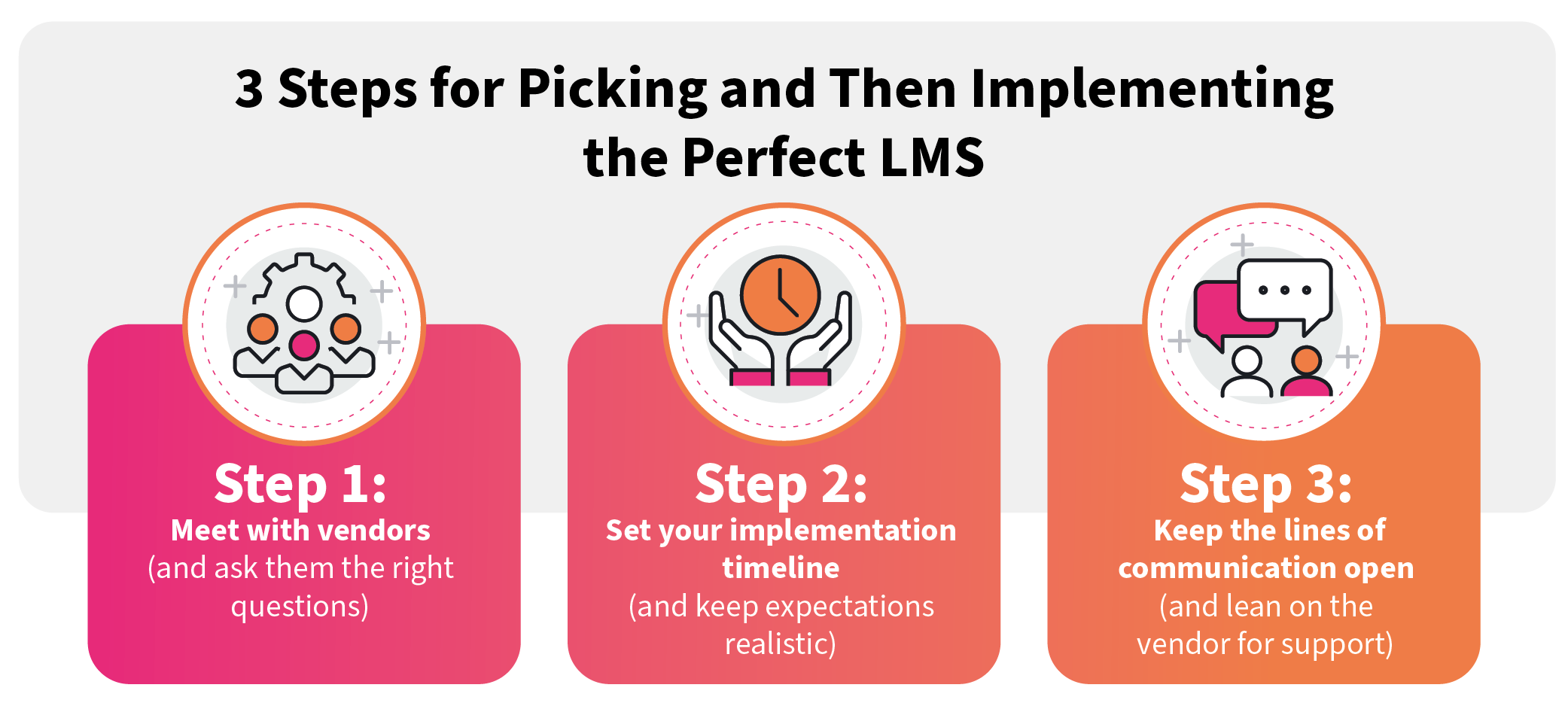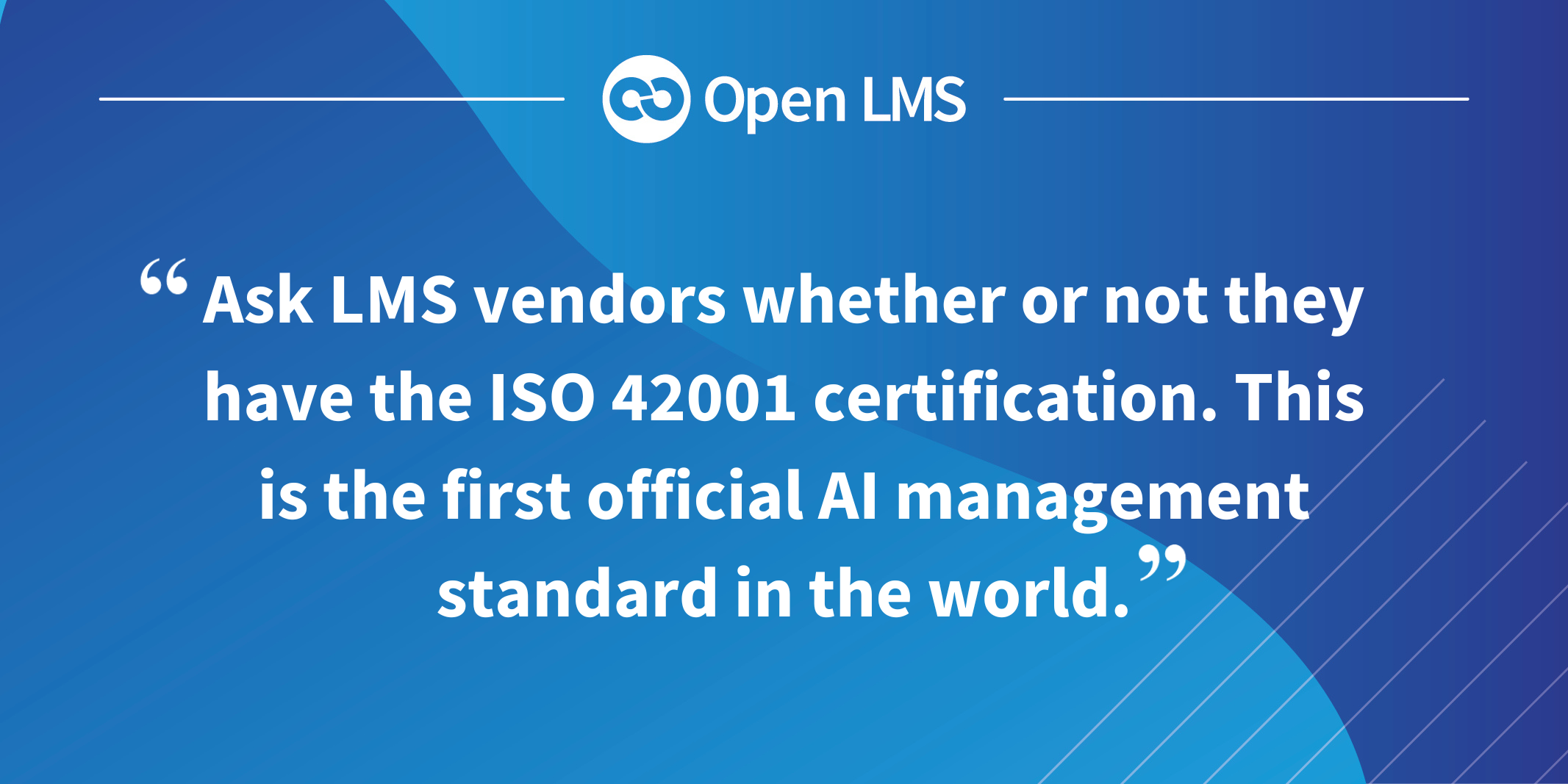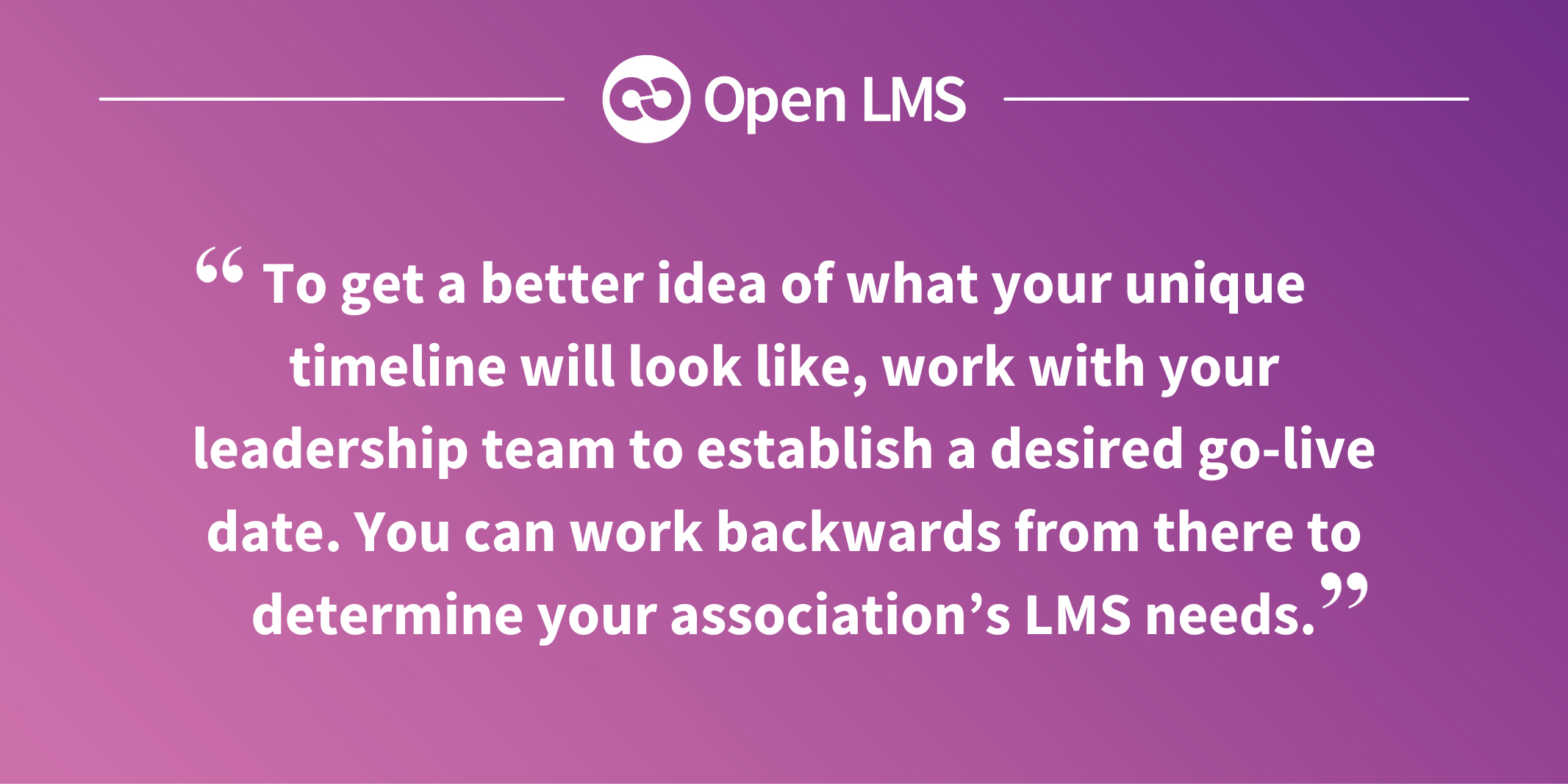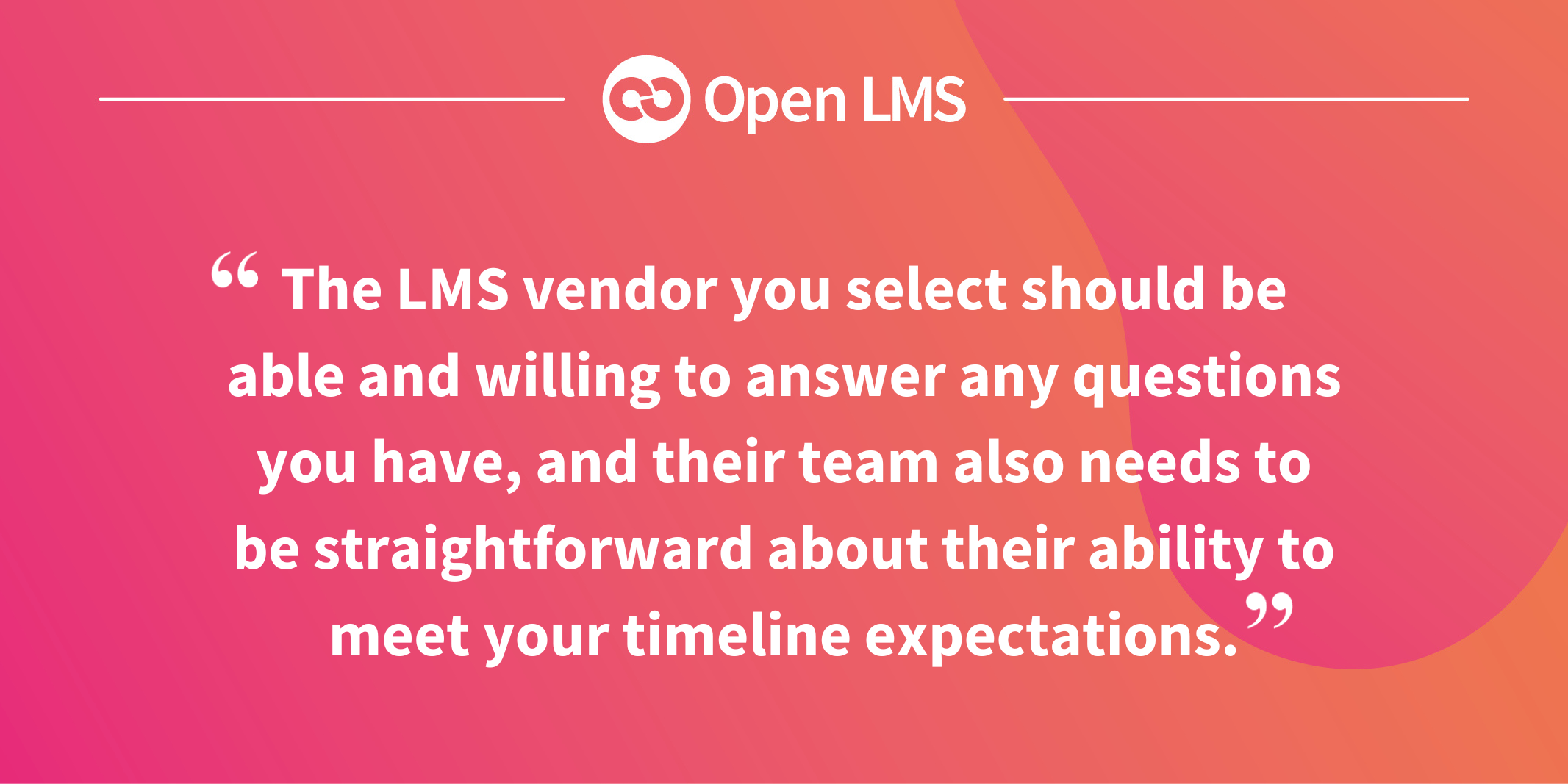How to Implement the Perfect LMS for Your Professional Association
It’s essential to choose an LMS that will help you maximize your association’s value proposition. Take time to speak with your leadership team and members, and establish how your new software will align with your current and future needs. Aligning your LMS search with your professional association’s goals will help you focus on features and capabilities that will best meet your needs.
After you’ve done that preliminary work, research LMS providers and create a shortlist of software partners that could be the right fit for your association. Then, it’s time to move on to the following three steps:

Step 1: Question Vendors
Ask vendors questions that go beyond the software basics. Many learning platforms offer similar features and tools that could likely suit your needs, so ensure that you’re also asking potential partners about their experience serving other associations or companies within your industry. They may not be able to give out specific client names, but providers should have case studies or similar examples that demonstrate their expertise.
To ensure your user information stays safe, you’ll also want to ask potential vendors how they manage their clients’ security. Ask whether they have any certifications from industry-recognized associations, such as the International Organization for Standardization (ISO). A particular certification to look for is ISO 27001, which focuses on how a platform manages the confidentiality, integrity, and availability of the data it handles and stores. When an LMS provider has this certification, it demonstrates the platform’s:
- Advanced data integrity, confidentiality, and availability
- Increased resilience to cyberattacks
- Preparedness to respond to new threats
RELATED READING | ‘Open LMS Formalizes Information Security Credentials With ISO 27001 Certification’

The continuing advancement of AI means you also need to ask questions about how vendors use the technology in their platforms. Go beyond asking about specific AI features and their benefits. Ask questions about how AI interacts with your members’ personal data and what security measures are being taken to ensure that the technology is used ethically.
Although it’s a relatively new standard, you should still ask LMS vendors whether or not they have the ISO 42001 certification. This is the first official AI management standard in the world, and LMS providers that have it:
- Possess a framework for managing risks and opportunities associated with AI
- Have demonstrated their responsible use of AI technologies
- Are balancing AI innovation with ethical responsibilities
Also consider asking:
- How do they support clients if technical problems arise?
- What reporting and analytics features are available?
- How is your information accessed, and how do they manage importing and exporting your sensitive data?
- What partner integrations are available?
- Do they offer flexible pricing models?
- Are all of the features and capabilities from the product demo included in the platform’s base price?
- Do they have access to your data during the contract, and how do they handle reporting edit requests?
- How can you secure the best future renewal rate?
GET TIPS FOR CHOOSING THE RIGHT LMS | ‘8 Must-Ask Questions Before Investing in Your Next LMS Platform’

Step 2: Know Your Implementation Timeline (And Set Realistic Expectations)
Your specific timeline will depend on where you are in your LMS search. Even if you’ve started making your shortlist of vendors, it’s unlikely that you’ll be going live with your new system in a month’s time. Having a realistic timeline will help you understand what to expect and avoid potential frustrations along the way.
The more complex your use case, the longer your implementation timeline will be. For instance, if you need to adhere to complex industry regulations, your go-live date with a new LMS vendor might take over a year (possibly longer in some circumstances).
To get a better idea of what your unique timeline will look like, work with your leadership team to establish a desired go-live date. You can work backwards from there to determine your association’s LMS needs. Ensure you ask potential vendors, “How long does it take to implement your software?” They won’t be able to give you a specific go-live date right away, but they should be able to offer you an estimate based on their other customers’ experiences.
HANDPICKED FOR YOU | ‘5 Strategies to Help You Enhance Your Professional Association’s Value Proposition’
Here’s an example timeline to give you a rough idea of how long it could take to implement a new LMS from start to finish:
- 15-18 months before your go-live date: Assess your learning needs and criteria for a new LMS
- 12-15 months before your go-live date: Research potential vendors and invite them to respond to your request for proposal (RFP)
- 9-12 months before your go-live date: Demo the LMSs on your shortlist. Ask specific questions. Choose your new LMS
- 6-9 months before your go-live date: Determine your data source. This likely includes your users, existing content, and/or any historic records. Start the change management process
- 3-6 months before your go-live date: Train your internal teams, such as administrators and your IT department
- 0-3 months before your go-live date: Import any final data and start phasing out your current training platform
- Go live with your new LMS!
READ A CASE STUDY | ‘How Sodimac Colombia Overcame an Unexpected LMS Migration and Boosted Training Delivery by 25%’

Step 3: Practice Open Communication
If a potential LMS vendor makes you feel like the implementation process is merely transactional, then they’re probably not the best fit. The relationship you forge with your provider should feel like being on a team that’s working toward a shared goal. You should feel welcome and able to actively collaborate with your LMS provider throughout the implementation process.
As part of the LMS implementation, you’ll assemble a team of internal stakeholders who will work directly with your new provider. It’s highly likely that these stakeholders will be taking on implementation tasks in addition to their standard workloads, so it’s imperative that your new provider is flexible enough to accommodate your team’s availability. As with any partnership, ensure that you’re also carving out adequate time to connect with your provider to keep the implementation process moving.
You also need to ensure that there is open communication between your team and your new provider. The LMS vendor you select should be able and willing to answer any questions you have, and their team also needs to be straightforward about their ability to meet your timeline expectations. Similarly, ensure you’re direct about your knowledge and understanding of their LMS and its capabilities. Ask questions if things aren’t clear. The right LMS partner will ensure that your association is comfortable and informed throughout the implementation process and beyond.
READ MORE ABOUT FLEXIBLE LMS PRICING | ‘How to Maximize ROI for Professional Associations With Flexible Seat-Based LMS Pricing’
